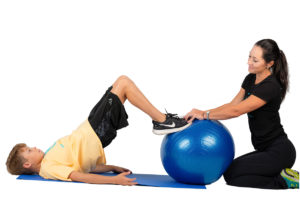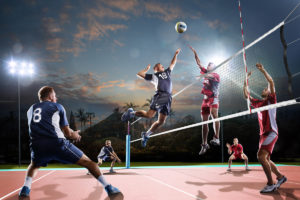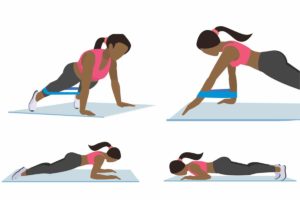Abdominals/Core
Rotational Power: Moving Beyond the Sagittal Plane
Many clients enthusiastically participate in rotational sports, such as golf, baseball, softball, tennis, pickleball, hockey, lacrosse, handball and volleyball. As fitness professionals, one major goal is to help our clients…
Standing Core Exercise
Standing core exercise is a great way to target, well, almost everything! These fast, effective options are creative and fun.
Core Training for Kids
There’s a tremendous need, now more than ever, to hook kids on fitness and equip them with good lifestyle habits. A child’s growing body needs regular movement in order to function optimally. Since the core is essentially “ground zero,” it’s a fitting place to start, because strong core muscles assist with posture and reduce the chance of injury. The key to a healthier tomorrow is to be proactive and get kids involved today.
A Strong Diaphragm for a Strong Core
When you think about exercising core muscles, do you remember your diaphragm? Its two main functions involve breathing and biomechanics, and it’s one of the most important muscles for maintaining intra-abdominal pressure (Nelson 2012). Intra-abdominal pressure is like a weight belt applied from the inside. If your body can’t regulate this pressure, you may experience poor motor control and lack of spinal stability. Plus, when the diaphragm is not properly engaged, other muscles must compensate, increasing your risk of injury.
Use Breath to Improve Core Stability
When your participants ask about their core muscles, they’re most likely referring to the lauded “six-pack.” As a fitness instructor, you may think about transversus abdominis, obliques and pelvic-floor muscles. But almost everyone tends to forget about the diaphragm.
Try Different Plank Variations in Your Class
Forearm plank, side plank, plank with hip dips—all are group exercise favorites. The plank is one of the most familiar and effective choices for core work, and it’s an easy addition. However, how many times can you program that same old plank? Fortunately, with a little creativity, a basic plank can be amazingly versatile. Just add simple movements and a little resistance to make an already challenging move even more interesting and effective.
Aching for the Quadratus Lumborum
Many of your clients likely work desk jobs and sit most of the day. This is not an ideal situation for many reasons, one being the risk of developing chronic lower-back pain. If you or a client is experiencing aches or sharp pains in the lower back, the issue may stem from problems with the quadratus lumborum.
Using Anti-Rotation to Coach Rotation
When you watch someone hit a golf ball, throw a punch or simply retrieve groceries from the car, it’s evident that human movement occurs in all three planes of motion. A review of basic core anatomy—major muscles attached to the trunk, above the ischial tuberosity and below the superior aspect of the sternum—reveals that 87.5% of the core muscles are oriented either diagonally or horizontally, and one action that these muscles perform is rotation (Santana 2000).
The Science of Pilates Research
When Victor Sanakai was playing tennis for the Auburn University Montgomery National Championship team, he thought he was going to need rotator cuff surgery. But first he sought the advice of Michele Olson, PhD, a Pilates researcher who works with student athletes.
Olson, a senior clinical professor of sport science at Huntingdon College in Montgomery, Alabama, suggested Sanakai try Pilates exercises for the shoulders, upper back and abdominals.
A Barre-Cardio-Core Class
When you take the strong, efficient movements of barre and mix in cardiovascular intensity and a comprehensive core routine, you get a winning combination for a full-body workout that appeals to a wide variety of people. Traditional barre classes use small, repetitive movements from a standing posture to work on balance while strengthening the lower body. Simultaneously, the upper body receives graceful range-of-motion benefits.
Breath and Movement for Core Stability
When your participants ask about their core muscles, they’re most likely referring to the lauded “six-pack.” As a fitness instructor, you may think about transversus abdominis, obliques and pelvic-floor muscles. But almost everyone tends to forget about the diaphragm.
Neuromuscular Power Circuits
The dynamic motions of sport require peak power—that is, the most strength a muscular contraction can muster in one of these quick bursts. Sporting athletes depend on peak power for jumping, running, throwing, striking, swinging and kicking. Scientists prefer the term “neuromuscular power” (to just “power” itself) because neural factors—including motor unit recruitment, muscle fiber firing frequency and synchronization of a muscle’s contractile forces—are involved.
Plank Variations
Forearm plank, side plank, plank with hip dips—all are group exercise favorites. The plank is one of the most familiar and effective choices for core work, and it’s an easy addition. However, how many times can you program that same old plank? Fortunately, with a little creativity, a basic plank can be amazingly versatile. Just add simple movements and a little resistance to make an already challenging move even more interesting and effective.
The following variations are best for participants who can hold a plank with
good form for at least a minute.
Yoga for Optimal Performance
Yoga, as both a philosophy and a physical practice, is one valuable tool to consider integrating into your training programs to help clients
Balance and Stability
Balance, which is essential for integrated movement, declines as we age. However, you can teach group fitness students how to maintain balance while also taking them through some fun, creative core exercises. Having a strong trunk and hip complex helps us maintain balance for years to come. In your next class, incorporate these multiplanar exercises targeting the core musculature and the gluteals. Each move is done in a standing position, and equipment is optional. Encourage attendees who struggle with balance to perform these exercises against a wall or while holding onto a barre.
Belly Fat vs. Vitamin D
Here’s another good reason for people to reduce their Buddha-bellies: improving their vitamin D status. According to data presented at the 2018 European Society of Endocrinology’s annual meeting in Barcelona, Spain, researchers from the Netherlands found that more body fat around adults’ waistline is associated with lower vitamin D levels. Beyond raising the risk of weak bones, poor vitamin D status could set the stage for other health issues, including heart disease and compromised immunity.
Strength Ladder
Strength training classes don’t have to adhere to a classic “sets and reps” template. Why not climb your way up and down this fun fitness ladder for a fast and furious total-body workout? Repetitions are high, but so is the frequency of change, keeping interest piqued during intense work sets.
Strength Ladder Details
GOAL/EMPHASIS: total-body strength training
TOTAL TIME: 1 hour
Barre Moves for Core Development
Barre classes focus on the core throughout the entire workout and have many ardent followers. Why not use barre-inspired moves in the core section of your HIIT or boot camp class? Your participants will love these variations on classic core fundamentals!
Location Is Everything When It Comes to BMI
The results are in: According to a new study, people who live within close proximity to a gym or activity center weigh less than those who don’t. Access to fast-food restaurants may also affect weight, say the study’s authors.
Primed to Squat
Why is it that so few people can squat correctly, yet my 8-year-old son squats perfectly? I’ve never taught him how to squat; he innately learned how, just as he learned to roll over, crawl, pull himself up and eventually walk. He simply needed the freedom to allow his body to move. Movement before strength is key.

















